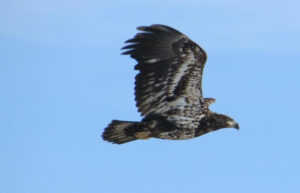Bald Eagle, Haliaeetus leucocephalus
Bill Rowe
As we move hopefully into 2021, let’s look at the national bird of the United States—a choice that Ben Franklin didn’t approve of, but one that appeals to just about everyone now, with its striking plumage and majestic size and bearing. “Eagle Days” are popular for good reasons. The bird’s scientific name, both parts from Greek, means “white-headed sea-eagle,” which sums up its identification but misses the mark a bit on its habitat: water, yes, and salt water at times, but fresh water just as much. Refuges and dams along rivers attract large winter concentrations of Bald Eagles, and nesting can occur near creeks and lakes almost anywhere (e.g., Florida, Minnesota, Missouri). This habitat choice stems from their preferred diet of fish, which can be live, dead, or stolen—that is, fish that were caught by another bird, like an Osprey, and then seized by an eagle. But this is only a preference; Bald Eagles will eat anything they can capture, including birds such as ducks and geese and mammals such as muskrats. This species, like many other raptors, has bounced back over the past 50 years from earlier low points in its population, owing to the banning of DDT, specific legislation that prohibits the intentional killing of eagles (formerly a widespread practice), and enforcement of the 1973 Endangered Species Act, under which it was protected until its successful rebound led to de-listing in 2007.
IDENTIFICATION: Adult plumage, with clean white head and tail, is attained by both sexes over 4-5 years. They start as all-dark-brown juveniles, then pass through various intermediate stages that may show a lot of patchy white on the head, the belly, the back, and other areas. Young Bald Eagles at all stages, even if very dark, show whitish mottling in the underwing, near the body; this is one good point of separation from the Golden Eagle, a rare bird here, which always has dark wing linings and “wingpits.” Even at great distances, a soaring Bald Eagle can be told from other large raptors by its flat wings.
ST. LOUIS STATUS: See above for the nationwide resurgence of Bald Eagle numbers. In terms of nests here in Missouri, this meant an increase from probably zero in 1980 to possibly 300 in 2020; some of these can be found here and there around St. Louis. In winter, with a big influx from farther north, the Bald Eagle is the commonest raptor along the Mississippi and can be seen in smaller numbers almost anywhere.
Learn more and listen to the calls of Bald Eagles here.
Huge stick nest, Loess Bluffs National Wildlife Refuge
Photo Credit: Al Smith
Immature, perhaps 2 years old
Photo Credit: Bill Rowe






